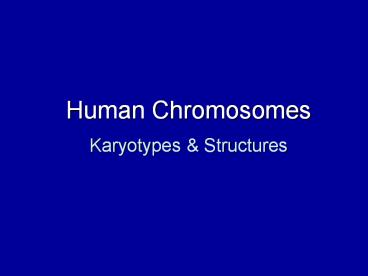Human Chromosomes - PowerPoint PPT Presentation
1 / 28
Title:
Human Chromosomes
Description:
Dicentric chromosomes contain two centromeres = abnormal separation ... abortions, which in turn. show chromosomal. abnormalities in 50%. Chromosome Deletions ... – PowerPoint PPT presentation
Number of Views:613
Avg rating:3.0/5.0
Title: Human Chromosomes
1
- Human Chromosomes
- Karyotypes Structures
2
Chromosome Stability Centromeres
- Centromeres are important to the separation of
chromosomes at anaphase during cell division - Dicentric chromosomes contain two centromeres
abnormal separation - Acentric chromosomes contain no centromere and
are often lost in cell division since they cannot
attach to spindle fibers
3
Chromosome Morphology
- Metacentric Centromere located in middle of
chromosome - Submetacentric Cent. located closer to one end
of chromosome - Acrocentric Cent. located near one end of
chromosome
4
Chromosome Polyploidy (???)
- Monoploidy basic set of chromosomes that is
multiplied in a polyploid - Haploid set of unpaired chromosomes found in
gametes - Diploid set of paired homologous chromosomes
found in most cells total number is fixed for a
species - Polyploidy genome composed of multiple complete
sets of chromosomes occurs in plants
5
Polyploidy
Chromosome numbers in Chrysanthemum
6
Extra or Missing Chromosomes
- Polysomy extra copies of single chromosomes in
a cell - Trisomy an extra copy of a chromosome
- Trivalent abnormal pairing of trisomic
chromosomes in cell division - Univalent extra chromosome in trisomy is
unpaired in cell division
7
Polysomy Trisomy
8
Human Chromosomes
- Humans have 46 chromosomes, including 22 pairs of
homologous chromosomes and two sex chromosomes - Karyotype stained and photographed preparation
of metaphase chromosomes arranged in homologous
pairs in descending size order
9
A Karyotype of a Normal Human Male
Chromosome painting
10
Human Chromosomes
- Chromosome maps are prepared by dividing the
chromosome into two regions (arms) separated by
the centromere - p short arm (petite) q long arm
- p and q arms are divided into numbered bands and
interband regions based on pattern of staining
11
Chromosomal Bands Interbands
12
Human X-Chromosome
- Females 2 copies of X chromosome
- One copy of X is randomly inactivated in all
somatic cells (dosage compensation) - Females are genetic mosaics for genes on the X
chromosome, since different X- linked alleles
will be expressed in different cells (single
active X principle) - Barr body inactive X chromosome seen
- during the interphase.
13
Abnormal Chromosome Number
- Trisomy of chromosome 21 most common autosomal
(non-sex chromosome) aneuploidy - Down Syndrome genetic disorder due to
chromosome imbalance aneuploidy - Sex chromosome aneuploidies include XXX (trisomy
X), XXY (Kleinfelter syndrom), XYY (double Y) and
X0 (Turner syndrom)
14
Down Syndrome Ch. 21 trisomy
15 of all pregnancies end up spontaneous
abortions, which in turn show
chromosomal abnormalities in 50.
15
Chromosome Deletions
- Deletions missing chromosome segment
- Large deletions are often lethal
- Polytene chromosomes of Drosophila can be used to
map physically the locations of deletions - Testcross mapping shows which wild-type alleles
are lost by deletion
16
Salivary Gland Polytene Nuclei
17
Gene Duplications
- Duplication chromosome segment present in
multiple copies - Tandem duplications repeated segments are
adjacent - Tandem duplications often result from unequal
crossing-over due to mispairing of homologous
chromosomes during meiotic recombination
18
Red-Green Color Vision Genes
- Green-pigment genes may be present in multiple
copies on the X-chromosome due to mispairing and
unequal crossing-over - Unequal crossing-over between these genes during
meiotic recombination can also result in gene
deletion and color-blindness
19
Unequal Cross-over of Tandem-repeats
Tandem-repeat cross-over in color blindness
20
Chromosome Inversions
- Inversions genetic rearrangements in which the
order of genes is reversed in a chromosome
segment - Inversions do not alter the genetic content but
change the linear sequence of genetic information - At synapsis, inversion loops form after
homologous pairing.
21
Chromosome Inversion Inversion Loop
22
Reciprocal Translocations
- Reciprocal translocations exchange of genetic
segments between non-homologous (unrelated)
chromosomes - There is no loss of genetic information, but the
functions of specific genes may be altered - Reciprocal translocation may affect one or both
pairs of chromosomes
23
Reciprocal Translocation
- Heterozygous translocation only one pair of
non-homologous chromosomes is affected - Homozygous translocation both pairs of
non-homologous chromosomes are affected - Synapsis involving heterozygous reciprocal
translocation results in pairing of four pairs of
sister chromatids quadrivalent - Chromosome pairs may segregate in several ways
during meiosis, with varying genetic outcomes in
gametes
24
Robertsonian Translocation
- Robertsonian translocation fusion of two
acrocentric chromosomes in the centromere region - Translocation results in apparent loss of one
chromosome in karyotype analysis - Genetic information is lost in the tips of the
translocated acrocentric chromosomes
25
Robertsonian Translocation
26
Abnormal Chromosomes Cancer
- Cancer cells contain many genetic abnormalities
including aneuploidies, translocations, deletions
and duplications of chromosome segments - Cancer is a clonal expansion of neoplasm
- Philadelphia chromosome first genetic
abnormality linked with a specific type of
cancer, chronic myelogenous leukemia (CML)
27
Chromosomal Break Points Oncogenes
28
Abnormal Chromosomes Cancer
- Philadelphia chromosome result of reciprocal
translocation between chromosomes 9 and 22 - Retinoblastoma gene tumor suppressor gene
contains a deletion in an inherited form of
cancer - Oncogenes are mutated forms of growth control
genes































